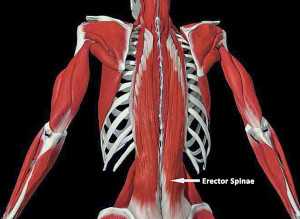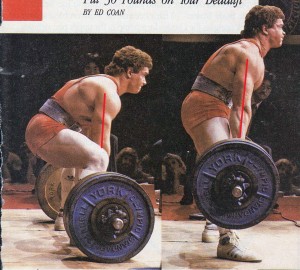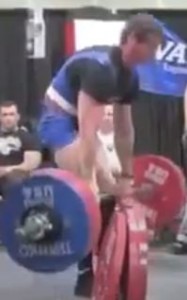One of the oldest and most controversial topics in terms of lifting weights is whether or not you will get hurt from rounding your back when you deadlift. Opinions tend to run the gamut. You’ll hear people suggesting that you instantly reset the weights you’re working with whenever you get even the smallest hint of back rounding. Others will tell you that you should just ignore back rounding altogether if you’re a real man. I don’t agree with either side, but I know my position will not be popular nonetheless.
If you’re looking for information on how pulling with a round back affects how much you can lift, see this article.
If you’d rather watch than read:
Lifting Weights and Back Injury
Let me draw an analogy between lifting weights and driving your car. We all know that there is a risk of getting in an accident every time you get in your car due to factors that are simply out of your control. You might be the victim of a drunk driver, a truck might lose control of some cargo, and you might simply find yourself in the wrong place at the wrong time. Any number of things could happen. Realistically, no matter how safe of a driver you are, there is always a chance that you could get screwed.
Well, in my opinion, the scenario is very similar when you lift weights. There are people who are simply genetically predisposed to disc herniation and other assorted back ailments. Lifting weights is just not a good match for these people. I would even go as far as to speculate that most people who hurt their backs lifting weights probably have some hereditary disposition towards back ailments in the first place. Even if you lift with perfect form, using a belt on every single set, for your entire lifting career, there is still a small chance that you will experience a significant back injury. You either accept this risk or you don’t. If you don’t, quit lifting. The choice is yours. You are a responsible adult capable of making logical decisions.
Just as there is a chance that you will get in car, drive off, and never come home, there is also a chance that you will go to the gym, pull a deadlift, snap your shit all up, visit snap city, and never come back. The risk of seriously hurting yourself is fairly low, but it is still there. It is your decision. Make a rational, calculated choice.
Rounding Your Back and Back Injury
In my opinion, rounding your back is analogous to being an aggressive driver: they weave in and out lanes, they run all the yellow lights, they speed, sometimes they text and drive, and they just engage in activities that increase the risk for an accident. There are some people who drink and drive dozens of times without any problems. Others get a DUI the very first time.
We can’t guarantee anything. This is all about risk factors. The more dangerous behaviors you engage in, the higher your risk is. Rounding your back is one such behavior.
Degrees of Flexion
Just as there are different levels of aggressive driving, there are different levels of back rounding that carry different levels of risk.
If every single vertebrae and disk in your back is completely rounded as much as it can possibly round this is a much riskier position than someone who exhibits a small deformation in position under heavy loads. If you’re rounding just a little bit, that is safer than rounding a whole lot, but it still isn’t as safe as a perfectly neutral spine.
Rounding Your Upperback
One of the common myths in the weight training world is that it is okay to round your upperback as long as you keep your lower back neutral. Personally, I find this to be a pile of B.S. for two reasons.
First of all, disk herniations in the t-spine are absolutely possible and occur all the time. While it is slightly less likely to happen on a deadlift than a lumber spine disk herniation, it could still happen. If you are trying to absolutely minimize the risk of an injury, upperback rounding is just as unacceptable as lower back rounding. It MIGHT be more safe than lower back rounding, but it still isn’t as safe as a neutral spine.
Secondly, your spine is not a freaking joint. You cannot consciously bend certain parts of the spine. The spine is interconnected by a series of facets; the entire thing is an interconnected system. If you are rounding your upperback, you are almost certainly rounding your mid-back to some degree and very likely rounding your lower back as well. People often get confused on this because lifters with huge spinal erectors don’t look like they’re rounding their lower back due to the simple fact that their muscles cover up the curvature of their spine. Rest assured, if you’re rounding your upperback to a significant degree, your entire spine is exhibiting some degree of rounding.

Notice how the erector spinae is all one giant, long muscle that runs up the entire spine. How can you preferentially flex part of it? Photograph: dynorock.wordpress.com
Rounding your upperback may be safer than full-fledged rounding, but it certainly isn’t as safe as a neutral spine.
The Actual Risk of Injury
In my opinion, all of these behaviors are still relatively low risk when it comes to back injuries. Now, why do I say that? There are two primary reasons.
The first is that nearly everyone who does heavy deadlifts rounds their back to some degree and serious back injuries and not all that common. In other words, for every back horror story you hear, there are literally hundreds if not thousands of gym bros doing round back deadlifts who walk away just fine.
As far as actual powerlifting goes, I am not sure if there are more than a handful of competitors who actually pull maximum weights with a perfectly neutral spine. It almost doesn’t exist. Many lifters pull incredibly heavy weights for 20-30 years with no problems whatsoever despite using a rounded technique. Now, it would be one thing if this was just an isolated case or two, but the reality is that nearly every competitive powerlifter does this. The risk just isn’t that big.

Ernie Frantz (right) was pulled into the 600s and 700s into his 70s.
Photo Credits: chicagopowerlifting.com
sweatpit.com
Recommendations
If you are a recreational lifter, you probably should not tolerate any back rounding whatsoever. There just isn’t any point in you needing to go that heavy. The increased risk isn’t really worth it. There are plenty of other ways to get bigger and stronger without the risk.
That said, if you’re a competitive powerlifter, freaking out every time you exhibit any sort of back rounding is the same thing as never getting into a car to avoid getting into an accident. Sure, you decrease the risk of injury and death, but you’re also being more than a bit irrational.
I don’t personally believe that you can ever achieve your deadlift potential if you don’t accept a little back rounding. Now, this is different if you pull sumo, but for you conventional pullers, which is most of you, you either accept a little bit of back rounding on heavy weights or you never get into your car to drive again. If you don’t want to accept the risks, that is fine. No one is forcing you to. But if you want to be a competitor, get over it.
You don’t freak out thinking about whether or not you’ll die every time you get into a car… so don’t freak out thinking about a disk herniation every time you have a little back rounding.
If you’d like more information on how rounding your back affects how much you can lift, check out this article.
Like this Article? Subscribe to our Newsletter!
If you liked this articled, and you want instant updates whenever we put out new content, including exclusive subscriber articles and videos, sign up to our Newsletter!
Questions? Comments?
For all business and personal coaching services related inqueries, please contact me:



Is it really that way? Is it true that I cant partially flex the spine?
“Notice how the erector spinae is all one giant, long muscle that runs up the entire spine. How can you preferentially flex part of it? ”
Well, sitting on a chair, I can definitely over-arch lower back and round upper back..and also round lower back and arch upper back at the same time. I bet you can do the same while deadlifting. You can choose position of both your lower and upper back, that means you can have lower back in neutral position and still round upper back.
Also, I have never felt pain in my thoracic vertebrae when rounding it, but I already felt couple of times very uncomfortable pain in my lumber spine while not keeping neutral position.
What do you think about it? i am just trying to figure this out….